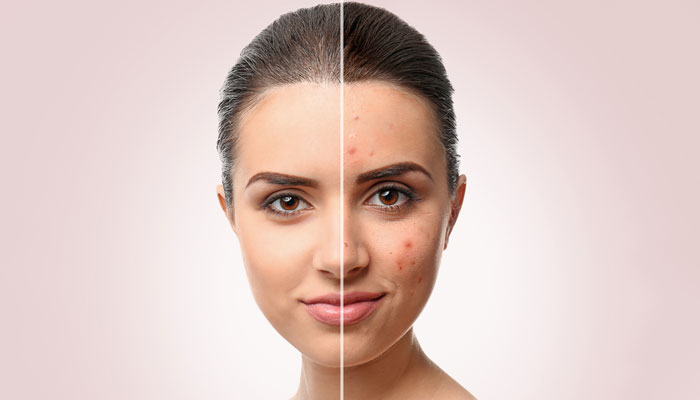
Acne scarring is a common problem but surprisingly difficult to treat. The scars can involve textural change in the superficial and deep layers of skin and may even cause the skin to darken. Acne is one of the most common skin disorders seen in dermatology, constituting about 30% of all dermatologic visits each year according to a standardized survey. Up to 34% of men and 27% of women report having active acne lesions at any given time. Acne can have a significant psychological and social impact, and for many people post-acne scarring can be especially devastating.
Acne, medically known as Acne Vulgaris, is a skin disease that involves the oil glands at the base of hair follicles. It commonly occurs during puberty when the sebaceous (oil) glands come to life. These glands are stimulated by male hormones produced by the adrenal glands of both males and females. While acne is not dangerous, it can leave skin scars. Human skin has pores that connect to oil glands located under the skin. The glands are connected to the pores via small canals called follicles. These glands produce Sebum, an oily liquid. The sebum carries dead skin cells through the follicles to the surface of the skin. A small hair grows through the follicle out of the skin. Pimples grow when these follicles get blocked, resulting in an accumulation of oil under the skin.
There are many different kinds of acne:
- Whiteheads are small and remain under the skin,
- Blackheads are clearly visible and appear on the skin surface,
- Papules are small, pink bumps visible on the skin surface,
- Pustules are red bumps with pus and clearly visible on the skin surface,
- Nobules are painful, large solid pimples clearly visible on the skin surface, and
- Cysts are pus filled, painful pimples, clearly visible on the skin surface. Cysts often cause scars. Scarring typically results from a severe inflammatory response to P acnes bacteria.
The extent and depth of the inflammation, in combination with the person’s response to the inflammation, will determine the amount, type, and depth of scarring. Severe inflammation of the dermis can lead to total necrosis of the follicle. This may lead to sloughing of the follicle, producing a focal scar. Ruptures that occur deeply in the follicle may result in inflammation that extends beyond the hair follicle, causing deep scarring and destruction of the subcuticular fat, leading to rolling scars.
In general, the treatment of acne scarring is a multistep procedure. At the start of treatment, the patient is examined to classify the subtypes of scarring that are present. Then, the patient is offered a menu of procedures to address various components of the scarring process. It is important to emphasize to the patient that acne scarring can be improved but never entirely reversed.
Different types of acne scars
Many different terms have been used to describe acne scars. The commonly used terms are ice pick, sharp shouldered, atrophic, and undulated or rolling. Jacob, Dover, and Kaminer (2001) proposed a three-term system: ice pick, rolling, and boxcar. Ice-pick scars are described as narrow, deep, sharply demarcated tracts. Rolling scars are relatively broad depressions in the skin that have rounded, sloping edges. Boxcar scars appear as round or oval depressions with sharply demarcated vertical edges. They are wider than ice-pick scars, and don't taper to a point at the base. They may be shallow or deep. Determining the types of scarring is important for choosing a treatment course.
Nykaa Recommends: Zenvista Dermanill Spot Reduction & Scar Removal Cream, GAIA Aromatherapy Acne Scar Minimising Gel and Zenvista Forest Botanicals Acne Pimple Scar Removal Turmeric Skin Toner
Want to get acne-free skin? Check out:

